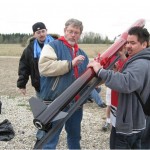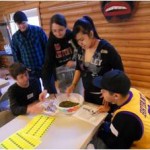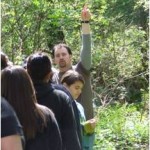By Gary Brandt
Whew! We’re back after an exciting adventure. First off, I could not be prouder of these folks! They were second to none. Oh, sure, there were those that knew more, but it was because they had the facilities such as wind tunnels, engineering departments, materials design labs, etc. not because they were any smarter. We looked very good in every category ranging from politeness, to timeliness, (“Of course NWIC is always first on the bus with everyone present”, Julie Clift, director) to knowledge of our rocket’s physics, to our science experiments, and to everything else. We did very well!
Our airplane left at 5:00am which meant very early wake up times. All made it in a timely fashion with varying degrees of enthusiasm. Only issue was that Kiya and Kiyen had their names submitted by Bellingham Travel somewhat incorrectly and that took some time to get straightened out. Hours of travel with stops in Seattle and Dallas got us to Huntsville, AL at 4:30 Central Standard Time. Our fifteen fit in nicely with the remaining 400 plus students from 25 different states. Our plane left at 5:00 on Sunday, the 17th.

Thursday saw introductions and tours. We did very very well. Our understanding is that we were the only team that had absolutely nothing to fix or modify after the very extensive safety inspection on Thursday evening. The external reviewers that interviewed Mariya, Thomas, and Gordon all commented on the high quality of their interviews. They were confident, knowledgeable and articulate.


On Friday, under a tornado watch, we presented our rocket at the rocket fair. Each team had a table/booth to display the rocket as well as any supportive posters, items, etc. We, of course, didn’t bring anything; however, several of the folks headed by Krissy and Nick, obtained a nice table cloth, a big bowl of candy and a, go figure, a bubble machine! Our booth attracted many, it looked good, and the students really not only knew what they were talking about, but presented it in a very informative and relaxed manner. Much pizza was consumed during that time.

The organizers postponed Saturday’s launch because of the weather. That evening we had a talking circle and worked on prepping rocket for Sunday’s launch.
Saturday was basically a free day until the banquet that evening. The banquet was held in the US Space & Rocket Center, beneath 300 foot long Saturn V rocket that was suspended over our heads. This is the rocket that took the Apollo astronauts to the moon. The food was excellent and plentiful. Several awards were given out, best web site, most innovative technology experiment (MIT), most outreach, and prettiest rocket.

Sunday we were on the first bus to leave at 5:30 am to go to the launch site, third to get our rocket prepared and inspected and fourth to get it launched. Mariya and Gordon were interviewed live over the Internet and the launches were also broadcast live. There was quite a long delay from setting the rocket on the pad until the actual launch time, in fact, over an hour, because of the usual “thank yous”, speeches by politicians and words by other dignitaries. This delay played a key role in some of our data collection.
Gordon and Mariya were interviewed prior to the launch. Here is the url and approximate start time on the video time line: http://www.ustream.tv/recorded/14092424 about 40:00. We finally got going and started the countdown for our rocket, Frankenstein II. The motor lit and off it shot. Unfortunately, the supplied launch pad collapsed and threw our rocket into an unstable trajectory that resulted in the rocket breaking in two. A collective “Ohhhhhh nooooo” came from the crowd of onlookers. Needless to say, we didn’t reach the target altitude of 5,280 feet, but more like 2,352 feet. Our rocket and team was totally exonerated from any fault as examination of the launch pad found two of the three cross braces had broken.
Here is the launch: http://www.ustream.tv/recorded/14093612 about 40 minutes on the time line. After the remaining fifteen launches our recovery team retrieved the rocket and we took it to the inspection folks and Frankenstein was examined. Again the conclusion was that it was the result of a faulty launch pad and the rocket broke in two because of the extraordinary stress placed longitudinally whereas rockets main strength is along the vertical axis. We were reassured that the launch itself was relatively minor, point wise. I asked if we could get extra points for style and entertainment. Krissy and Justin were interviewed about the flight. The URL and approximate start time on the video time line: http://www.ustream.tv/recorded/14097263 about 41:25.
We went back to the motel prior to all of the rockets launching because check out time was 1:00 and our flight left at 5:00. A bunch of tired folks arrived at Bellingham International at 11:40 pm. Whew!
– Gary Brandt, Instructor of Computer Technology













